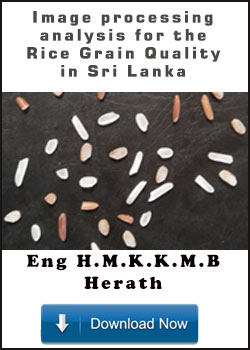| Image processing analysis for the rice grain quality in Sri Lanka by Eng H.M.K.K.M.B Herath |
| |
| |
|
|
 |
|
Rice is the single most important food in the Asian countries, especially in Sri Lanka. According to the Ministry of Agriculture in Sri Lanka, rice occupies an an average of 37% of the total cultivation in Sri Lanka. For the global demand rice is exported to other countries (approximately 1000 MT) and global rice demand is increasing by 1.95%, annually. As technology grows, industries and peoples are getting adapted to new technologies rather than using old techniques. More and more people are consuming rice as food, so the demand is increasing. This is the reason why the process of bagging and packaging of rice is becoming automated. At present grain-handling system, grain type and quality are rapidly assessed by visual inspection.
|
| |
|
Rice grains are primarily classified according to its grain shape, colour etc. This article presents the use of a machine vision system for grain classification. Machine vision has been used in most application of grain classification to differentiate rice varieties based on special features such as shape, length, chalkiness, colour and internal damage of rice. RGB colour model, histogram, edge detection are some ways which have been used to differentiate and analyse the rice grains. In this article we also discuss and suggest methods to classify four varieties of rice and also find the percentage of purity of rice grains using the image processing technics.
The purpose of the image processing techniques is to test the quality of the rice grain. The quality of the rice grain is based on the several parameters. Fragments of the grain are highly effective to the quality of the rice. Machine vision systems are used to identify the quality of the grain. Digital images and videos are the key source of the machine vision systems. When the grains are mixed together machine vision system needs to identify contents of the grain mixture. In here, grains are classified according to its colour and the size. This article introduces how to filter and classify four types of rice in a grain mixture. Rice sample represent four varieties of rice grains (Red Basmati, White Basmati, Red Samba and White Samba) mixed together. Sample is comprised with different colour and different shapes of grains.
|
| |
|
 |
| |
| "All Council Members can be contacted via email or phone by first login as a member to MyIESL and then acceding the Council Directory. It is also possible to communicate your concerns from anywhere in the world by posting them to the Forum - Meet The President and Council from the Forum page" |
| |
|